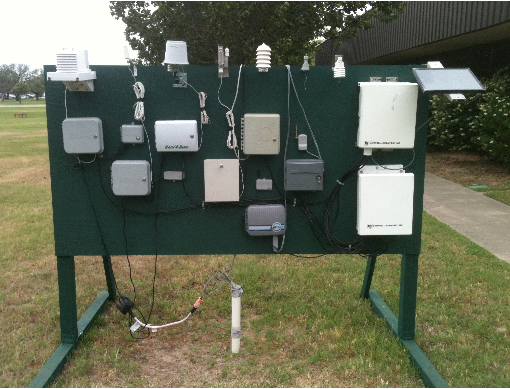Why Most Smart Irrigation Controllers Failed the Drought Test

PHOTO COURTESY OF TEXAS AGRILIFE EXTENSION SERVICE
Nine 'smart' irrigation controllers were tested during the 2011 drought.
A new report by the Texas AgriLife Extension Service says that only a few smart irrigation systems worked right during the drought.
What’s a smart irrigation system? Normal sprinkler systems require their owners to manually set irrigation schedules. But, smart irrigation controllers use an array of sensors to determine just how much water is needed and when, conserving water.
Ideally, the sensors on smart controllers measure water loss due to evaporation, rainfall, temperature, solar radiation, and even relative humidity. The system should then use these measurements to determine just how parched the landscape is and when is best to apply irrigation.
But many of the controllers failed to meet plant water requirements over a testing period of 152 sweltering days.
The reason? Dr. Guy Fipps, an AgriLife Extension irrigation engineer, suggests that some controllers were simply unable to adapt.
“No single controller was consistently able to provide the correct amount of water for all six zones tested during all seasons,” Fipps says in AgriLife Today. “During the drought, evapotranspiration [or the amount of water needed by plants to survive] was 30 to 50 percent higher than average years. Some controllers did not adjust to the extreme conditions and applied inadequate amounts.”
The new report indicates that two of the nine controllers tested delivered twice the necessary amount of water to plants on a regular basis. Overall, the controllers applied the proper amount of water only 37 percent of the time.
While their performance was generally lackluster, the report says that the controllers have improved from those of years past. And controllers with on-site sensors appeared to fare better, adjusting irrigation during the extreme drought by factoring in harsher temperatures, decreased humidity, lower rainfall, and increased wind speeds. Devices that used off-site sensors, however, relied on average measurements and weren’t always able to adjust watering needs accurately.
Fipps believes that these findings could better inform the average consumer bent on purchasing one of these devices. All controllers tested are currently available for both residential and commerical use.
“If you’re considering purchasing one of these devices, you should do your research first. Buy the controller that performs the best for your particular landscape,” Fipps tells StateImpact Texas.
While no controller tested was perfect, a few controllers did perform better with certain types of plants. Depending on whether your landscape contains more turf, flowers, or hardy shrubs, you may have to reconsider which smart irrigation controller actually makes the grade.
Sheyda Aboii is an intern with StateImpact Texas.
